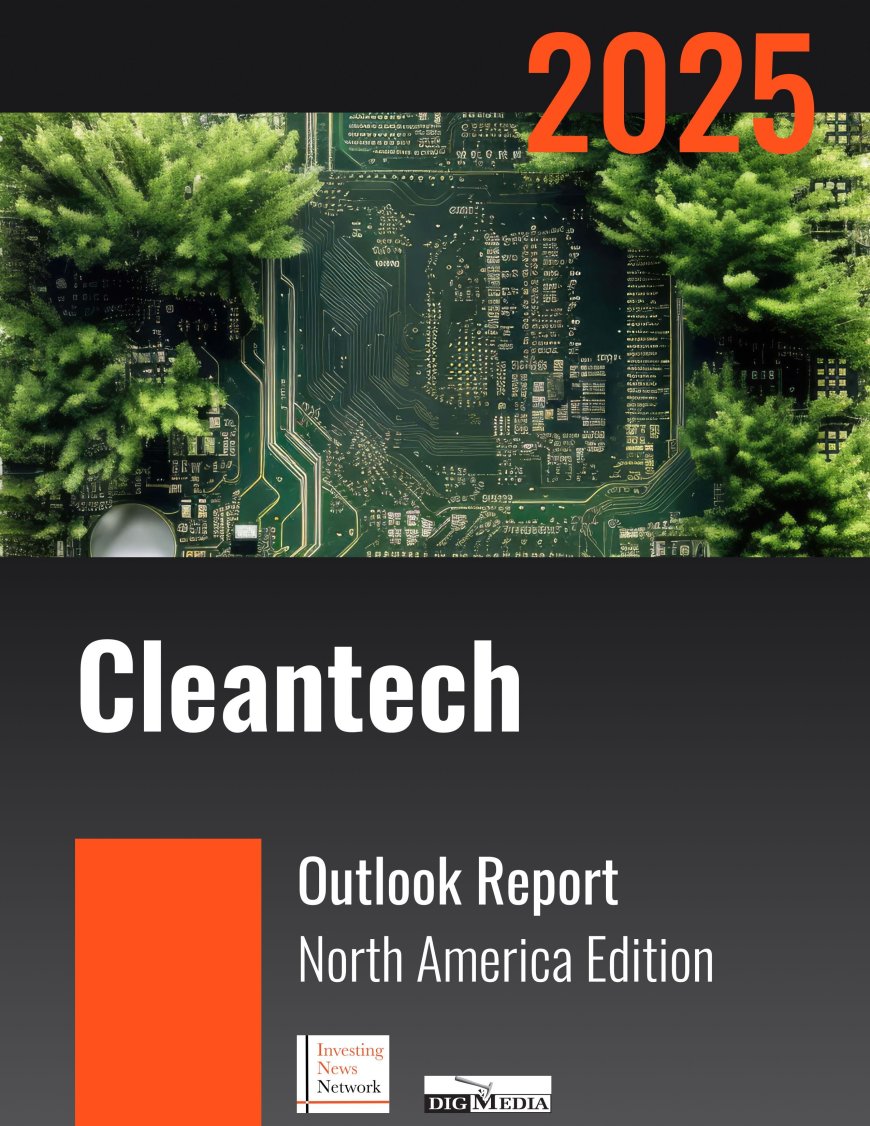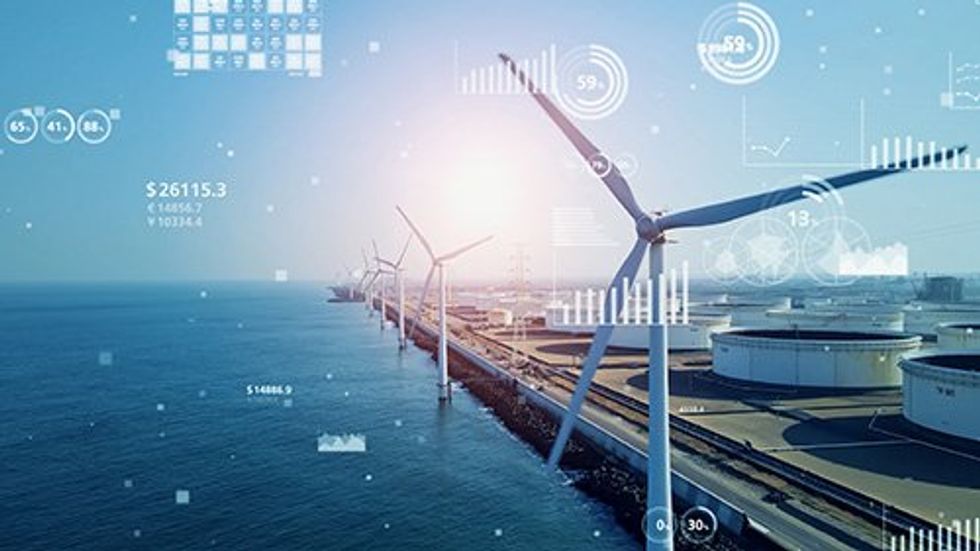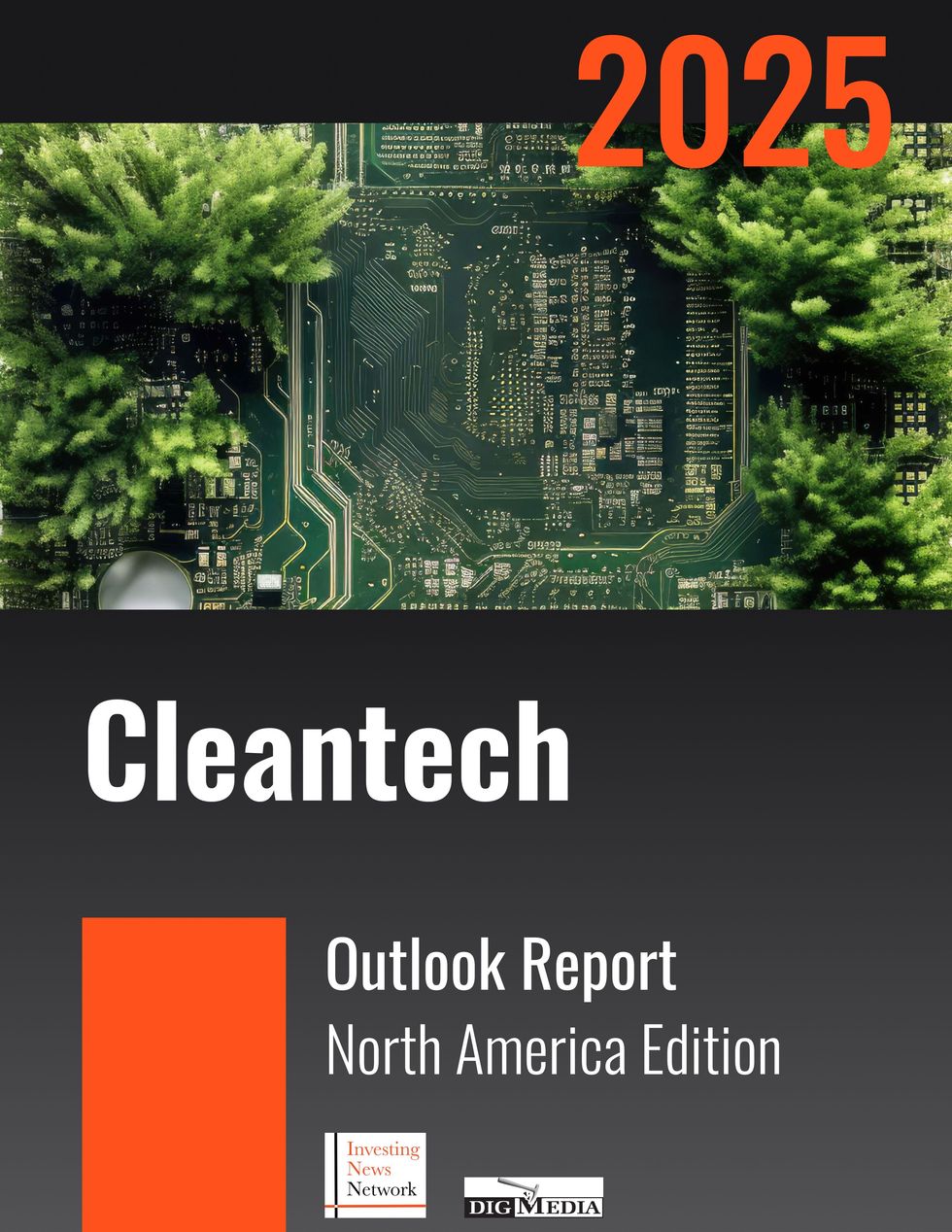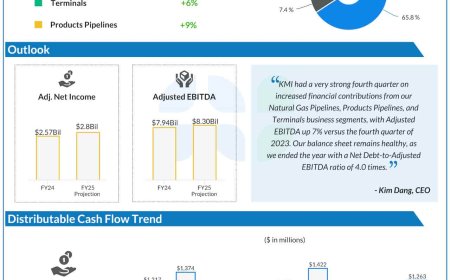2025 Cleantech Outlook Report
2025 Cleantech Outlook Report Carbon capture is set to gain steam. What are the other trends you need to watch? The Investing News Network spoke with analysts, market watchers and insiders about which trends will move the cleantech sector. ✓ Trends ✓ Forecasts ✓ Top Stocks Table of Contents: Cleantech Market Forecast: Top Trends for Cleantech in 2025 5 Best-performing Canadian Cleantech Stocks 5 Biggest Clean Energy ETFs Who We Are The Investing News Network is a growing network of authoritative publications delivering independent, unbiased news and education for investors. We deliver knowledgeable, carefully curated coverage of a variety of markets including gold, cannabis, biotech and many others. This means you read nothing but the best from the entire world of investing advice, and never have to waste your valuable time doing hours, days or weeks of research yourself. At the same time, not a single word of the content we choose for you is paid for by any company or investment advisor: We choose our content based solely on its informational and educational value to you, the investor. So if you are looking for a way to diversify your portfolio amidst political and financial instability, this is the place to start. Right now. Cleantech Market Trends and Cleantech Stocks to BuyTable of Contents Cleantech Market Forecast: Top Trends for Cleantech in 2025 5 Best-performing Canadian Cleantech Stocks 5 Biggest Clean Energy ETFs Cleantech Market Forecast: Top Trends for Cleantech in 2025 The escalating energy demands of today's increasingly digital world are pushing the limits of the power grid in the US and elsewhere, necessitating a faster shift toward sustainable energy solutions. What does the future hold for the cleantech industry as it leads the charge in addressing these issues in 2025? Here the Investing News Network explores the implications of rising energy consumption, the role of cleantech innovation in meeting this demand and how government policies could help or hinder the sector. AI explosion to boost demand for clean energy Clean energy has always been part of the energy transition, but as the artificial intelligence (AI) sector gains traction the importance of green sources of energy is becoming increasingly crucial. AI energy requirements are set to surge dramatically, potentially straining current energy grids and infrastructure. A December report from Grid Strategies predicts energy providers will need to add up to 128 gigawatts (GW) of new capacity by 2029 to keep up with demand, a noteworthy increase from an estimate of 39 GW just last year. Data centers are projected to consume up to 35 GW by 2030. Innovative sustainable energy solutions and cooling technologies will need to be developed to meet demand without derailing decarbonization efforts. The AI industry’s energy demands are being further amplified by the construction of new chip-manufacturing facilities. To promote chip production to the US, President Joe Biden's Chips and Science Act has pledged billions to Intel (NASDAQ:INTC), Taiwan Semiconductor Manufacturing Company (TSMC) (NYSE:TSM) and Samsung Electronics (KRX:005930) to help them expand their American production capacity. Intel is updating its facilities in Oregon, New Mexico and Arizona, and has plans to finalize new fabs in Ohio in the coming years. TSMC plans to eventually operate three fabs in Arizona, while Samsung is expanding its operations in Texas to include two factories, a research and development factory and a packaging facility. These new facilities, with their substantial energy needs, will increase an already significant strain on existing infrastructure. Demand will necessitate upgrades to the existing power grid and require expansions to accommodate the increased load of multi-year operations. The source of this additional energy will be a crucial consideration, as a shift towards renewable energy sources will be essential to mitigate the environmental impact of ever-growing energy demands.Nuclear and geothermal energy emerged as two promising carbon-free options in 2024. Microsoft (NASDAQ:MSFT), for instance, has signed a 20 year power purchase agreement with Constellation Energy (NASDAQ:CEG) to purchase carbon-free electricity from the soon-to-be-restarted Unit 1 reactor at Three Mile Island.Similarly, Amazon’s (NASDAQ:AMZN) Climate Pledge Fund joined a US$500 million funding round in October to back a startup company, X-energy, that’s developing a Generation IV high-temperature gas-cooled pebble-bed nuclear reactor. X-energy's Xe-100 is a small modular reactor (SMR) that is more compact, simpler and safer than traditional reactors.News of Amazon’s deal broke just a week after Alphabet’s (NASDAQ:GOOGL) Google announced a power purchase deal with Ka


2025 Cleantech Outlook Report
Carbon capture is set to gain steam. What are the other trends you need to watch?
The Investing News Network spoke with analysts, market watchers and insiders about which trends will move the cleantech sector.
| ✓ Trends | ✓ Forecasts | ✓ Top Stocks |
Table of Contents:
|

|
Who We Are
The Investing News Network is a growing network of authoritative publications delivering independent, unbiased news and education for investors. We deliver knowledgeable, carefully curated coverage of a variety of markets including gold, cannabis, biotech and many others. This means you read nothing but the best from the entire world of investing advice, and never have to waste your valuable time doing hours, days or weeks of research yourself.
At the same time, not a single word of the content we choose for you is paid for by any company or investment advisor: We choose our content based solely on its informational and educational value to you, the investor.
So if you are looking for a way to diversify your portfolio amidst political and financial instability, this is the place to start. Right now.
Cleantech Market Trends and Cleantech Stocks to Buy

Table of Contents
Cleantech Market Forecast: Top Trends for Cleantech in 2025
5 Best-performing Canadian Cleantech Stocks
Cleantech Market Forecast: Top Trends for Cleantech in 2025
The escalating energy demands of today's increasingly digital world are pushing the limits of the power grid in the US and elsewhere, necessitating a faster shift toward sustainable energy solutions.
What does the future hold for the cleantech industry as it leads the charge in addressing these issues in 2025?
Here the Investing News Network explores the implications of rising energy consumption, the role of cleantech innovation in meeting this demand and how government policies could help or hinder the sector.
AI explosion to boost demand for clean energy
Clean energy has always been part of the energy transition, but as the artificial intelligence (AI) sector gains traction the importance of green sources of energy is becoming increasingly crucial.
AI energy requirements are set to surge dramatically, potentially straining current energy grids and infrastructure. A December report from Grid Strategies predicts energy providers will need to add up to 128 gigawatts (GW) of new capacity by 2029 to keep up with demand, a noteworthy increase from an estimate of 39 GW just last year.
Data centers are projected to consume up to 35 GW by 2030. Innovative sustainable energy solutions and cooling technologies will need to be developed to meet demand without derailing decarbonization efforts.
The AI industry’s energy demands are being further amplified by the construction of new chip-manufacturing facilities.
To promote chip production to the US, President Joe Biden's Chips and Science Act has pledged billions to Intel (NASDAQ:INTC), Taiwan Semiconductor Manufacturing Company (TSMC) (NYSE:TSM) and Samsung Electronics (KRX:005930) to help them expand their American production capacity.
Intel is updating its facilities in Oregon, New Mexico and Arizona, and has plans to finalize new fabs in Ohio in the coming years. TSMC plans to eventually operate three fabs in Arizona, while Samsung is expanding its operations in Texas to include two factories, a research and development factory and a packaging facility.
These new facilities, with their substantial energy needs, will increase an already significant strain on existing infrastructure. Demand will necessitate upgrades to the existing power grid and require expansions to accommodate the increased load of multi-year operations.
The source of this additional energy will be a crucial consideration, as a shift towards renewable energy sources will be essential to mitigate the environmental impact of ever-growing energy demands.
Nuclear and geothermal energy emerged as two promising carbon-free options in 2024. Microsoft (NASDAQ:MSFT), for instance, has signed a 20 year power purchase agreement with Constellation Energy (NASDAQ:CEG) to purchase carbon-free electricity from the soon-to-be-restarted Unit 1 reactor at Three Mile Island.
Similarly, Amazon’s (NASDAQ:AMZN) Climate Pledge Fund joined a US$500 million funding round in October to back a startup company, X-energy, that’s developing a Generation IV high-temperature gas-cooled pebble-bed nuclear reactor. X-energy's Xe-100 is a small modular reactor (SMR) that is more compact, simpler and safer than traditional reactors.
News of Amazon’s deal broke just a week after Alphabet’s (NASDAQ:GOOGL) Google announced a power purchase deal with Kairos Power to deploy 500 megawatts (MW) of nuclear power by 2030 using reactor technology.
More recently, on December 4, Meta (NASDAQ:META) communicated a request for proposals to nuclear developers, saying it is seeking up to 4 GW of new nuclear power for its data centers. Welcoming collaboration from both SMRs and larger nuclear reactors, Meta emphasized the need for early engagement and scaled deployments to reduce costs.
Oklo (NYSE:OKLO), a company with strong ties to OpenAI CEO Sam Altman due to his early investment and role as chairman of the board, signed a deal in late December with data center operator Switch to build SMRs to power its data centers. Switch’s clients include Google, NVIDIA (NASDAQ:NVDA) and Tesla (NASDAQ:TSLA), among others.
In addition to nuclear energy, geothermal energy is a viable solution for data centers' high energy consumption. Google's partnership with NV Energy leverages what’s known as a Clean Transition Tariff to secure 115 MW of geothermal power for Google’s data centers, outsourced from Fervo Energy's enhanced geothermal system.
Meta is also pursuing geothermal sources for its energy needs, signing a power purchase agreement with Sage Geosystems in August. The first phase of the project is scheduled to become operational by 2027.
Furthermore, the increased power consumption of AI technologies necessitates more efficient cooling methods. According to analysis from Zainab Gilani, a research associate at the Cleantech Group, liquid cooling offers superior performance and scalability compared to traditional air cooling, particularly direct-to-chip cooling.
Companies like NVIDIA and Intel are working to advance liquid cooling solutions for data centers, including collaborating with cooling technology providers like CoolIt Systems.
In its global outlook report for 2025, BlackRock explains how investors could benefit from this trend, highlighting the utility sector as a potentially attractive avenue for indirect investment in the AI boom.
EVs, tariffs and trade under Trump
The EV market grew globally in 2024, but in the US it faces a complex and uncertain landscape.
While consumers have more EV options than ever after a wave of newly introduced models from automakers like Ford (NYSE:F), Toyota (NYSE:TM) and Rivian (NASDAQ:RIVN), adoption initiatives put in place by the Biden administration are at risk of being defunded or repealed under President-elect Donald Trump.
For example, Trump wants to eliminate the Inflation Reduction Act, although he would need Congressional approval.
In a December interview with Yale Environment 360’s Elizabeth Kolbert, Professor Leah Stokes of the University of California Santa Barbara said corporate lobbying will be instrumental in retaining some aspects of the act.
“The things that will be on the table are largely (clean energy) tax credits because the grants will be mostly out the door by the time the Biden administration wraps up at the beginning of January,” she said. “These tax credits are benefiting companies, and you’re already seeing the reporting that for even the most vulnerable tax credits, which I would assume are the EV tax credits, there’s a constituency out there trying to defend those. Companies have made investments that take years to really come to fruition, and they can’t really turn around on a dime.”
Tax incentives to spur investment have also created thousands of jobs, particularly in Republican states. This may encourage Trump to selectively choose which programs to cut.
“When you think about all the manufacturing investments that are in these Republican districts, it’s not just the manufacturing jobs that matter,” Stokes continued.
“You start to realize that all those investments in making stuff in America, they want to sell that stuff in America too. And in order to sell that stuff in America, they need the other tax credits for deployment."
In her view, the IRA may turn out to be "a much stickier policy" than many expect.
One additional factor to consider is Trump's approach to international trade, particularly with regard to tariffs. Given the importance of lithium in the production of EV batteries, changes in trade policies involving countries with significant lithium reserves and processing capabilities, such as China, could impact the EV industry.
The proposed tariffs run the risk of provoking retaliatory measures from other countries, including trade barriers. Such a response could escalate into a trade war, with negative consequences for all involved economies.
Sodium-ion batteries, especially if they become commercially viable and cost-effective, could reduce US dependence on China for lithium-ion battery materials and technology.
In April 2024, Osaka Metropolitan University shared research focused on the challenging task of developing a new process for mass producing solid sulfide electrolytes for sodium-ion batteries. This new method has the potential to enable the production of solid-state sodium batteries that could be scaled up for mass production.
Sodium-ion batteries offer other advantages such as improved safety, lower costs due to the abundance of sodium and potentially higher energy density compared to traditional lithium-ion batteries.
Investor takeaway
The cleantech sector is poised for change in 2025, driven by escalating energy demand and the push for sustainability. Advances in nuclear and geothermal energy offer promising solutions, while innovations in battery technology and cooling solutions further support the transition toward a cleaner future.
Overall, the cleantech industry's trajectory depends as much on policy decisions as it does on technological advancements and the global push for sustainability. Industry leaders’ ability to innovate and adapt will be crucial in shaping a cleaner and more energy-efficient future.
Don’t forget to follow us @INN_Technology or real time updates!
Securities Disclosure: I, Meagen Seatter, hold no direct investment interest in any company mentioned in this article.
Editorial Disclosure: Charbone Hydrogen and Westport Fuel Systems are clients of the Investing News Network. This article is not paid-for content.
5 Best-performing Canadian Cleantech Stocks of 2024
The global transition to a green economy has been a boon for the cleantech market — it's helping investment in renewable energy and clean technology continue to grow, allowing the sector to keep building momentum.
Analysts see a few key trends dominating the cleantech sector worldwide, including solar and wind energy, agricultural technology, electric vehicles (EVs), EV infrastructure and clean energy commercial long-haul transportation solutions.
Heading into 2025, here’s a look at the best-performing Canadian cleantech stocks on the TSX and TSXV year-to-date; CSE companies were considered, but none made the list at this time.
Data for this article was gathered on December 29, 2024, using TradingView’s stock screener. Only companies with market capitalizations greater than C$50 million are included.
1. Anaergia (TSX:ANRG)
Year-to-date gain: 260 percent
Market cap: C$152.37 million
Share price: C$0.90
Anaergia is a global company that specializes in converting waste, including wastewater and agricultural and municipal solid waste, into renewable energy, clean water and organic fertilizer.
It has operations in 17 countries spanning North America, Africa, Asia and Europe.
On July 10, Anaeriga announced the completion of a strategic investment, saying it had closed the third tranche of a C$40.8 million investment deal with Marny Investissement. The deal gives Marny a controlling interest in Anaergia as it now owns over 60 percent of the company's outstanding shares.
In December, the company extended its reach with new contracts to operate in California. It also signed a deal to provide organic waste as an energy source for PepsiCo's (NASDAQ:PEP) operations in Colombia.
Anaergia is slated to attend several cleantech conferences around the world in 2025.
2. BIOREM (TSXV:BRM)
Year-to-date gain: 223.23 percent
Market cap: C$51.58 million
Share price: C$3.20
BIOREM is a cleantech engineering company that develops air emissions abatement technologies using biological processes like biotrickling filtration, a process by which polluted gas is absorbed and degraded by microorganisms into harmless substances. The company's systems are capable of removing a wide array of pollutants, and it can design effective solutions tailored to meet specific needs and site requirements.
The firm collaborates with municipalities, industrial facilities, oil and gas companies and landfill operators.
3. Tantalus Systems (TSX:GRID)
Year-to-date gain: 143.75 percent
Market cap: C$95.28 million
Share price: C$1.95
Tantalus Systems provides technology that gives utilities greater control and insight into their electric grids.
This includes advanced metering infrastructure (AMI), load management systems and grid analytics, all of which contribute to a more efficient and reliable power grid.
One of its key products, TRUConnect AMI, provides real-time data on energy consumption and grid conditions. The TRUFlex Load+DER Management system helps manage energy demand and integrate distributed energy resources like solar power, while TRUGrid Automation optimizes grid operations and improves response to events like power failures.
4. CVW CleanTech (TSXV:CVW)
Year-to-date gain: 25.33 percent
Market cap: C$136.03 million
Share price: C$0.94
CVW CleanTech is focused on making the Canadian oil sands industry more sustainable.
The company's technology recovers bitumen and valuable minerals like titanium and zircon from oil sands tailings ponds, reducing the environmental impact of oil and gas production.
In 2024, the company transitioned to a royalty-based model, investing in other cleantech companies in exchange for a share of their revenue. Its first royalty investment was in Northstar Clean Technologies (TSXV:ROOF,OTCQB:ROOOF), a company with technology that processes end-of-life asphalt shingles into components including liquid asphalt, as well as aggregate and fiber for industrial use. The deal was finalized in September.
5. DynaCERT (TSX:DYA)
Year-to-date gain: 9.37 percent
Market cap: C$76.83 million
Share price: C$0.18
DynaCERT specializes in improving the fuel efficiency of diesel engines with its HydraGEN technology, which expanded into South American mines in 2024. The system adds hydrogen to the air intake of the engines, which reduces the emissions of pollutants like nitrogen oxide, resulting in cleaner combustion.
The company's technology works with traditional diesel engines and is being used across a wide range of heavy-duty industries, including transportation, mining and construction.
In recent years, DynaCERT has been collaborating with another alternative fuel company, Cipher Neutron, to accelerate the development of Cipher Neutron’s alkaline exchange membrane (AEM) electrolysis technology, a cheaper, more efficient method of producing green hydrogen. On June 11, DynaCERT acquired 15 percent ownership of Cipher Neutron.
On July 16, DynaCert announced that Cipher Neutron had been awarded a contract for a joint project with Simon Fraser University (SFU) in BC, Canada. The university hosts the SFU Clean Hydrogen Hub, at which Cipher Neutron will develop and deploy two 250 kilowatt AEM electrolyzer stacks. The technology splits water into hydrogen and oxygen using electricity, making it a key process for producing low-cost green hydrogen.
Don’t forget to follow us @INN_Technology for real-time news updates!
Securities Disclosure: I, Meagen Seatter, hold no direct investment interest in any company mentioned in this article.
5 Biggest Clean Energy ETFs in 2024
Exchange-traded funds (ETFs) have been gaining popularity in North America in a wide range of industries, including the clean energy sector, whose appeal is rapidly increasing.
For investors looking to gain exposure to the cleantech market, investing in individual stocks can be daunting considering the broad reach of this market sector, which includes renewable energy technologies such as wind and solar; battery technologies for electric vehicles and large-scale energy storage systems; agritech, water treatment and air purification systems; built environment technologies; carbon capture and green hydrogen.
ETFs have become so popular partially because they provide a safer way for investors to gain exposure to various industries while avoiding the volatility that comes with investing in individual stocks.
Below is a look at the five top clean energy ETFs to consider, ranked by total assets. All numbers and figures were gathered using ETFdb.com and were current as of February 29, 2024. Read on to learn more.
1. iShares Global Clean Energy ETF (NASDAQ:ICLN)
Total assets: US$2.48 billion
The iShares Global Clean Energy ETF was created on June 24, 2008, and has a large portfolio of domestic and international stocks. An analyst report on the ETF states that it "likely doesn't deserve" a large weighting in an investor's long-term portfolio. It suggests that the fund could instead be useful as a "satellite holding" that looks at a fraction of the market that is often overlooked by less focused ETFs.
Three of the iShares Global Clean Energy ETF's top-weighted holdings include: Enphase Energy (NASDAQ:ENPH) at 8.81 percent, First Solar (NASDAQ:FSLR) with a 7.64 percent weighting and Nextracker (NASDAQ:NXT) at 4.93 percent.
2. First Trust NASDAQ Clean Edge Green Energy Index Fund (NASDAQ:QCLN)
Total assets: US$837.32 billion
The First Trust NASDAQ Clean Edge Green Energy Index Fund, which came into existence on February 14, 2007, is a "unique member" of the alternative energy category, according to ETFdb.com. Why? Because it invests in companies that have interests in different green energy subsectors, such as biofuels, solar energy and advanced batteries.
ETFdb.com also states that because of this ETF's focus, it may be appealing to investors looking for broader exposure in the alternative energy sector. Three of its highest-weighted holdings are ON Semiconductor (NASDAQ:ON) at 8.83 percent, First Solar at 7.75 percent and Tesla (NASDAQ:TSLA) at 6.93 percent.
3. Invesco WilderHill Clean Energy ETF (ARCA:PBW)
Total assets: US$366.32 million
Begun on March 3, 2005, the Invesco WilderHill Clean Energy ETF focuses on clean energy companies using green and renewable energy and technologies that help with cleaner energy.
Currently this ETF's top-weighted holdings include Nextracker at 2.37 percent, Solid Power (NASDAQ:SLDP) at 2.12 percent and American Superconductor (NASDAQ:AMSC) at 2.08 percent.
4. ALPS Clean Energy ETF (ARCA:ACES)
Total assets: US$230.22 million
The ALPS Clean Energy ETF was formed fairly recently, on June 29, 2018. The majority of the companies in this ETF are based in North America. The top three holdings of the ETF are Enphase Energy at a weight of 6.13 percent, Itron (NASDAQ:ITRI) at 5.9 percent and Albemarle (NYSE:ALB) at 5.75 percent.
5. SPDR S&P Kensho Clean Power ETF (ARCA:CNRG)
Total assets: US$213.84 million
The SPDR S&P Kensho Clean Power ETF was launched in October 2018 and tracks companies whose products and services are driving innovation in the clean energy sector, including the areas of solar, wind, geothermal and hydroelectric power.
The fund currently has 51 holdings. The top three by weight are Nextracker at 3.71 percent, Constellation Energy (NASDAQ:CEG) at 3.37 percent and General Electric (NYSE:GE) at 3.13 percent.
This is an updated version of an article originally published by the Investing News Network in 2018.
Don't forget to follow us @INN_Technology for real-time news updates!
Securities Disclosure: I, Melissa Pistilli, hold no direct investment interest in any company mentioned in this article.











































